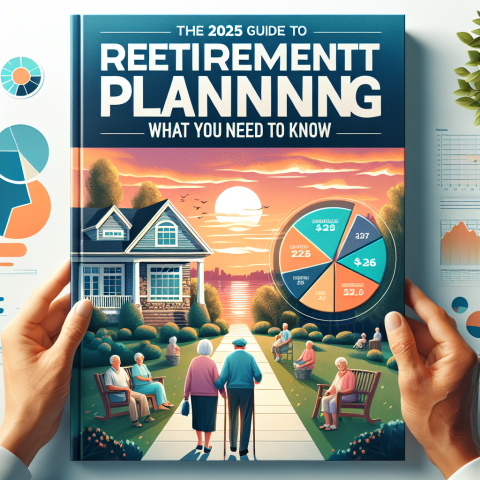Retirement Planning – I’ll be honest: when I first started thinking about retirement planning, it felt like trying to read a foreign language. The jargon, the investment strategies, the retirement accounts—it all seemed so complicated and far off. But as I’ve gotten older and a bit wiser, I’ve realized that retirement planning doesn’t have to be intimidating. In fact, it’s one of the most important things we can do for our future selves.
So, let’s talk about how retirement planning is shaping up for 2025 and why now—yes, right now—is the best time to start. Trust me, I’ve learned this lesson the hard way.

The 2025 Guide to Retirement Planning: What You Need to Know
1. It’s Never Too Early (Or Too Late) to Start Planning
If you’re like me, you’ve probably put off thinking about retirement because it feels like “way down the road.” I used to think that retirement planning was something you only needed to worry about when you were in your 40s or 50s, but I quickly learned that it’s never too early to start. In fact, the earlier you start, the better. Why? Because compound interest is your best friend.
A few years ago, I stumbled upon a compound interest calculator (I know, thrilling, right?). But seeing how much even small contributions could add up over time was eye-opening. I realized that if I just set aside a little money each month, my future self would thank me big time. If you’re in your 20s or 30s, start now. Even if you only contribute a small percentage of your income, you’ll be amazed at how much it will grow over the years.
That said, it’s also not too late to start if you’re a little older. Retirement is a marathon, not a sprint, so there are still plenty of ways to catch up, especially if you focus on maximizing your contributions to retirement accounts. Which leads me to…
2. Max Out Your Retirement Accounts
One of the easiest ways to save for retirement is by taking advantage of tax-advantaged accounts. In 2025, there are some solid options for retirement savings, and I wish I’d known how powerful these accounts could be when I was just starting out. Let’s talk about a few of the big ones:
- 401(k): If your employer offers a 401(k) plan, definitely take advantage of it. And if they offer a match? It’s like free money. I can’t stress this enough—don’t leave that on the table. I remember when I started my first job and didn’t fully understand the power of employer matching. I missed out on a good chunk of retirement savings because of that. Don’t make the same mistake!
- IRA (Individual Retirement Account): If your employer doesn’t offer a 401(k), or if you just want to save more, an IRA is a great option. For 2025, you can contribute up to $6,500 to a traditional or Roth IRA (or $7,500 if you’re over 50). The key difference between the two is how they’re taxed—Roth IRAs grow tax-free, while traditional IRAs allow you to deduct contributions now and pay taxes when you withdraw.
It’s easy to forget about these accounts when life gets busy, but regularly contributing to them is one of the best things you can do for your future.
3. Diversify Your Investments
Alright, so now that you’re contributing to your retirement accounts, the next step is making sure your money is working for you. Diversification is a big deal here. Instead of putting all your eggs in one basket, you should spread your investments across a variety of asset classes—stocks, bonds, real estate, etc.
I made the mistake early on of putting most of my savings in a few stocks I was “sure” would do well. Spoiler alert: they didn’t. In hindsight, I wish I’d diversified my portfolio more to include some bonds and index funds, which tend to be more stable over time.
For 2025, consider low-cost index funds and exchange-traded funds (ETFs). These funds allow you to invest in a wide range of stocks, providing a safer bet than putting all your money into a handful of individual companies. And don’t forget about international stocks or real estate—diversification isn’t just about the U.S. market.
4. Don’t Forget About Healthcare Costs
Here’s something I didn’t fully grasp when I first started thinking about retirement: healthcare is expensive. In fact, one of the biggest expenses in retirement will likely be healthcare costs. And unfortunately, Medicare doesn’t cover everything.
As we’re looking at retirement in 2025, it’s important to plan for healthcare costs ahead of time. A Health Savings Account (HSA) can be a great way to save for medical expenses, as it offers tax advantages and can be used in retirement. In 2025, you can contribute up to $3,850 for an individual or $7,750 for a family to an HSA (and even more if you’re over 55).
It’s also worth considering long-term care insurance if you’re concerned about needing extra assistance in later years. I didn’t even think about this until a friend mentioned it to me, and now it’s on my radar for future planning.
5. Monitor and Adjust Your Plan Regularly
Retirement planning isn’t a “set it and forget it” kind of thing. You need to revisit your plan regularly to make sure you’re on track. I’ll admit, I used to set my retirement contributions and then forget about them for a couple of years. But things change—market conditions, your income, your life goals—all of these things should factor into your plan.
One of the best pieces of advice I’ve gotten over the years is to have an annual check-in with yourself or a financial advisor. Is your portfolio performing the way you expected? Do you need to increase your contributions? Are you taking full advantage of tax-advantaged accounts? It’s also a good time to rebalance your portfolio if necessary, adjusting your investments based on how close you are to retirement.
6. Start Thinking About Your Retirement Lifestyle
Finally, this is the fun part: what do you want your retirement to look like? Are you planning to travel the world? Start a new hobby? Volunteer? Having a clear picture of your desired lifestyle will help you determine how much you need to save and how aggressive you should be with your investments. The more specific you can get, the better.
A few years ago, I sat down and made a list of things I’d love to do when I retire. Some of them were big (like traveling to places I’ve always dreamed of) and some were smaller (like finally learning how to play the piano). By identifying those goals, I’ve been able to structure my retirement plan around them.
In conclusion, retirement planning doesn’t have to be overwhelming, but it does require a little attention and effort. The key is starting as early as possible, maximizing your contributions to tax-advantaged accounts, diversifying your investments, planning for healthcare costs, and regularly checking in on your progress. By making small changes today, you’ll be setting yourself up for a much more comfortable and stress-free retirement in the future. It’s not as complicated as it seems—it just takes a little time and intention. You got this!



